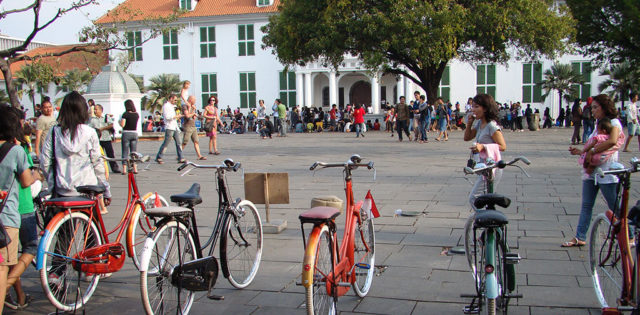
A New Urban Marketplace to Address the Needs of Our Time
juin 4, 2015 — Uncategorized
They say that necessity is the mother of invention. With all the need that exists in the world today, I would say we are in for a lot of innovation.
The world has been facing some tremendous challenges—both natural and manmade: earthquakes, tsunamis, and drought, civil unrest and social disenfranchisement, infrastructure breakdown and shifts in population size, age and population density around the world.

By the middle of this century, the number of people living in cities is projected to climb from 4 billion to more than 6.5 billion people. Asian cities are at the center of this urban flux. India and China’s combined urban populations are projected to grow by 700 million people by 2050. And in 10 years, Indonesia’s urban population will reach 183 million, up from 120 million today. Greater Jakarta (Jabodetabek) will grow to more than 40 million by 2050 from the current 27 million inhabitants today—more than 9.6 million currently live in Jakarta (DKI) proper.
Safe drinking water is a challenge in cities in many developing countries. For Jakarta, providing clean water to all of its 9.6 million (and growing) residents is a huge challenge. On top of this, the city faces heavy traffic and high flood risks. More than ever, there is a critical need to tailor urban services to make them more effective and efficient. This is true not only for Jakarta, but for all cities globally.
In order to build thriving cities, many government agencies, domain experts and service providers will need to work in even greater coordination than ever before. They must be able to access and respond to real-time data in an agile fashion and anticipate need before it actually arises. Therefore, we believe the circumstances, technological sophistication and timing are right for the emergence of a robust global urban services marketplace that can address cities’ challenges and deliver the right services.
Breaking Down the Silos
To successfully seize the opportunities associated with the current shifts and anticipate what is coming, city leaders need to view challenges in an integrated fashion. Typically, issues such as education, healthcare, traffic, parking, lighting, security, waste management and water management have been assessed in silos.
City leaders must not only look at the root of the challenges their cities face—the causes of traffic, the real costs of medical treatment, the limitations of the current education systems—but also break down the silos and recognize and address the interrelationship of these challenges in seeking sustainable solutions.
To keep up with the rapid influx of new city dwellers, the constraints on resources and budgets, the effects of climate change and other critical factors, leaders must turn to technology—which continues to become more powerful and less expensive (as Moore’s Law implies).
Already, cities around the world are realizing the moment is now to invest in a smart digital infrastructure, one that can support a city’s physical infrastructure along with its processes, people, and data, and can leverage mobile and sensing devices. That same infrastructure must also help to enrich the livability of a city by providing a means for citizen engagement and a respect for resources, the environment, and the nuances of a city’s cultural identity—the stuff that makes it different from other cities. And it must do so in a way that makes the city more economically viable and sustainable, too.
Harnessing Technology to Drive Collaborative Cities
With the cost of computing, storage and bandwidth dropping, the use of technology to address challenges is opening up new possibilities. Faster, smaller, smarter devices are bringing together data in new ways. The connectivity of smart objects—and there may be as many as 75 billion connected devices and machines as well as objects and people by 2050—is already beginning to demonstrate some tangible benefits. According to the technology industry analyst firm Gartner, almost 1.1 billion of those connected things will be used by smart cities this year alone: buses, light poles, traffic signals, garbage cans, park sprinklers, water pipes, the list of objects and processes becoming connected is nearly endless.
Increasingly, the Internet of Everything offers new ways to make our lives as citizens smarter, more efficient and more informed – while, at the same time, delivering cost savings to government. Connected infrastructure – from toll roads, to parking places to utility meters – delivers real-time “actionable” information around costs, conditions, usage and utilization to citizens and government alike. Citizens can find available parking immediately or reduce electricity use at home, while government can allocate the right resources at the right time to a wider range of citizens and charge appropriate fees, deliver services, and manage public infrastructure.
Public sector organizations can leverage IoE capabilities for more direct citizen engagement and feedback, and to make high-impact changes to how services are being delivered. The plethora of data from sensors, cameras, social media, and many other sources will continue to build as more devices become connected. Not only will Cisco and its ecosystem of partners continue to develop solutions for cities, citizens and businesses for smarter traffic, smarter parking, smarter lighting, smarter and easier access to government information and other services, but we will have a lot of company.
Opening up legacy and new data streams has already begun stimulating a new economic tour de force in the form of throngs of application developers around the globe—in big and small companies, in start-ups and incubators—busy crafting applications that can make sense of the data onslaught and deliver actionable, context-relevant information both to humans and to other machines…an enormous new urban services marketplace.
This marketplace has the potential to offset the costs of driving new service-delivery models with incremental revenue-generating business models.
From Local to Global
Suppose your city requires urgent assets at short notice, such as an extra firetruck or an earth mover, and a nearby city has these available. New technologies would allow the need to be surfaced and the surplus to identified more quickly. And applications could perhaps even manage the transfer and usage agreements with equitable terms benefiting both cities. Suppose this type of business exchange could happen with a reach further than the next town over.
When cities take their operations to a connected digital infrastructure to address local challenges, there is a secondary benefit. When services data is made available via the Internet, services management can be done from anywhere, creating a global urban services marketplace.

Take the major issue of water management. In Israel—where the water is a matter of life and death—water-management vendors TaKaDu and Hagihon have joined forces and are taking their combined expertise to the global urban services marketplace. Connected leak-detecting sensors and other specialized equipment provide water management not only locally – for Jerusalem and other towns in Israel – but also globally to such far-flung cities as Adelaide, Bilbao, and Singapore.
Many Layers of Expertise
Effectively transforming challenges takes the combined efforts of government, industry, academia and individuals with innovative ideas to make it a reality.
Cisco is already working with a growing ecosystem of partners with expertise in many areas—the beginnings of the marketplace for global urban services — which has been valued at roughly $3 trillion over the next eight years in new revenue and cost savings opportunities for the public sector. Opportunities are unfolding rapidly for developers to create applications that tame and frame the data for use by cities, citizens and businesses.
We’ll continue to evolve our partnerships and our solutions as the challenges and the technologies evolve. It is a very exciting time — we know you’ll stay tuned for what’s coming.
Anil Menon is a featured speaker at the New Cities Summit in Jakarta on June 9 -11.